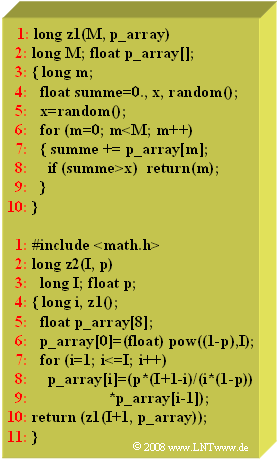Exercise 2.7: C Programs "z1" and "z2"
From LNTwww
The two C programs given here are suitable for generating discrete random variables:
- The function $z1$ generates an $M$–level random variable with the value set $\{0, 1$, ... , $M-1\}$. The associated probabilities are passed in the array $\text{p_array}$ with property "Float" The function $\text{random()}$ returns equally distributed float–random variables between $0$ and $1$.
- A second function $z2$ (source code see below) returns a special probability distribution specified by the two parameters $I$ and $p$. This is done using the function $z1$.
Hints:
- The exercise belongs to the chapter Generation of Discrete Random Variables.
- In particular, reference is made to the page Generation of multilevel random variables.
Questions
Solution
(1) After the first iteration of the loop $(m = 0)$ the variable $\text{sum = 0.2}$, at the next iteration $(m = 1)$ holds $\text{sum = 0.2 + 0.3 = 0.5}$.
- In both cases, therefore, the variable $\text{sum} < x = 0.75$.
- Only when $m = 2$ is the return (bin hier nicht sicher) condition satisfied: $0.9 > x$. Thus $\underline{z1 = 2}$.
(2) The correct solutions are solutions 2 and 3:
- Were we to dispense with the auxiliary variable $x$ and write in line 8 instead $\text{sum > random()}$ a new random value would be generated on each iteration of the loop, and $z1$ would then not have the desired properties.
- $z1$ works according to the diagram on the page "Generation of multistage random variables" in the theory section. There you find a much faster implementation for the case of equal probabilities $(1/M)$.
- In the first run $(m = 0)$ in this case the return condition is not satisfied due to the less/equal–query; the output value is actually $z1 = 1$.
(3) The correct solutions are 1, 3, and 4:
- It results in a binomially distributed random variable, with the set of values $\{0, 1, 2, 3, 4\}$.
- For the calculation of the probability ${\rm Pr}(z2 = 0) = (1 -p)^{I}$ one needs the mathematical library.
- But exponentiation could also be realized by $I$–fold multiplication.
(4) Because of line 6, the field element $\text{p_array[0]}$ before the program loop $(i = 0)$ contains the value $(1 -p)^{I}$.
- In the first iteration $(i = 1)$ the following value is entered:
- $$\text{p_array[1]}=\frac{ p\cdot I}{ 1- p}\cdot\text{p_array[0]}= I\cdot p\cdot(1- p)^{ I- 1}={\rm Pr}(z2= 1) .$$
- In the second iteration $(i = 2)$ the probability for the result "$z2=2$" is calculated:
- $$\text{p_array[2]}=\frac{p\cdot (I- 1)}{ 2\cdot ( 1- p)}\cdot\text{p_array[1]}= \left({ I \atop { 2}}\right)\cdot p^{\rm 2}\cdot( 1- p)^{\rm 2}={\rm Pr}( z2 = 2) .$$
- For $I= 4$ and $p = 0.25$ we get the following numerical value ⇒ "$4$ over $2$" $=6$:
- $$\text{p_array[2]}={\rm Pr}( z 2=2)=6\cdot\frac{1}{16}\cdot\frac{9}{16} \hspace{0.15cm}\underline{=0.211}.$$
